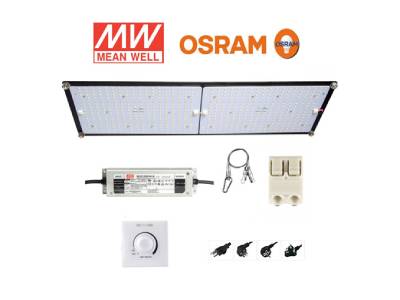1. The light of different wavelengths of LED Plant Lights has different effects on plant photosynthesis. The light required for plant photosynthesis has a wavelength of about 400-700nm. 400-500nm light and 610-720nm contribute the most to photosynthesis.
2. The blue (470nm) and red (630nm) LEDs can just provide the light needed by plants, so the ideal choice is to use these two color combinations. In terms of visual effects, the red and blue plant lights are pink.
3. Blue light helps plant photosynthesis to promote green leaf growth, protein synthesis, and fruit formation; red light can promote plant rhizome growth, help flowering and fruiting and prolong flowering, and increase yield!
4. The ratio of red and blue LEDs of Classic Led Grow Lights is generally between 4:1--9:1, and usually 6-9:1.

Led Grow Light
5. When plant lights are used to supplement light for plants, the height from the leaves is generally about 0.5-1 meters, and continuous exposure for 12-16 hours a day can completely replace sunlight.
6. The effect is very significant, and the growth rate is almost 3 times faster than that of natural plants.
7. Solve the problem of lack of sunlight in the greenhouse in winter, promote the chlorophyll, anthocyanin and carotene needed in plant photosynthesis, so that fruits and vegetables are harvested 20% earlier, increasing the yield by 3 to 50%, and improving the sweetness of fruits and vegetables. And reduce pests and diseases.
8. LED light source is also called semiconductor light source. This light source has a relatively narrow wavelength and can emit light of a specific wavelength, so it can control the color of the light. Using it to irradiate plants alone can improve plant varieties.
9. The power of Led Grow Lights is low, but the efficiency is extremely high. Because other lights emit full spectrum, that is to say, there are 7 colors, but the plants need only red light and blue light, so most of the light energy of traditional lights Wasted, so the efficiency is extremely low. The LED plant growth lamp can emit the specific red and blue light required by the plant, so it is extremely efficient. This is why the power of a few watts of the LED plant growth lamp is better than that of several tens or even hundreds of watts. Another reason is the lack of blue light in the spectrum of traditional sodium lamps, and the lack of red light in the spectrum of mercury lamps and energy-saving lamps, so traditional lamps have a much worse light supplementation effect than LED lamps, and they save more than 90% of energy compared to traditional lamps. The cost is greatly reduced.
Copyright:@2020-2021
Comments Please sign in or sign up to post.
0
0 of 500 characters used